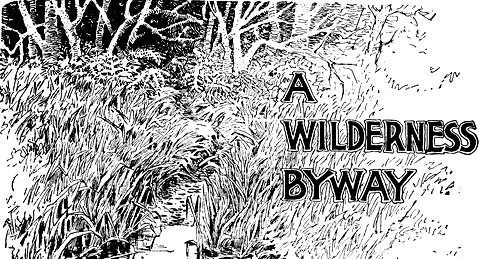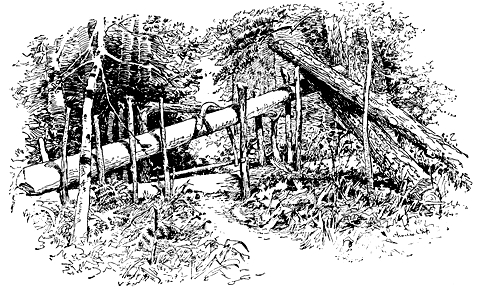| 1999-2003 (Return to Web Text-ures) |
Click Here to return to Beasts of the Field Content Page Click here to return to the previous chapter |
 (HOME) |
| 1999-2003 (Return to Web Text-ures) |
Click Here to return to Beasts of the Field Content Page Click here to return to the previous chapter |
 (HOME) |
 A WILDERNESS BYWAY. ONE day in the wilderness, as my canoe was sweeping down a beautiful stretch of river, I noticed a little path leading through the water grass, at right angles to the stream’s course. Swinging my canoe up to it, I found what seemed to be a landing place for the wood folk on their river journeyings. The sedges, which stood thickly all about, were here bent inward, making a shiny green channel from the river. On the muddy shore were many tracks of mink and muskrat and otter. Here a big moose had stood drinking; and there a beaver had cut the grass and made a little mud pie, in the middle of which was a bit of musk scenting the whole neighborhood. It was done last night, for the marks of his fore paws still showed plainly where he had patted his pie smooth ere he went away. But the spot was more than a landing place; a path went up the bank into the woods, as faint as the green waterway among the sedges. Tall ferns bent over to hide it; rank grasses that had been softly brushed aside tried their best to look natural; the alders waved their branches thickly, saying: “There is no way here.” But there it was, a path for the wood folk. And when I followed it into the shade and silence of the woods, the first mossy log that lay across it was worn smooth by the passage of many little feet. As I came back, Simmo’s canoe glided into sight and I waved him to shore. The light birch swung up beside mine, a deep water-dimple just under the curl of its bow, and a musical ripple like the gurgle of water by a mossy stone — that was the only sound. “What means this path, Simmo?” His keen eyes took in everything at a glance, the wavy waterway, the tracks, the faint path to the alders. There was a look of surprise in his face that I had blundered upon a discovery which he had looked for many times in vain, his traps on his back. Das a portash,” he said simply. “A portage! But who made a portage here?” “Well, Musquash he prob’ly make-um first. Den beaver, den h’otter, d’en everybody in hurry he make-um. You see, river make big bend here. Portash go ‘cross; save time, jus’ same Indian portash.” That was the first of a dozen such paths that I have since found cutting across the bends of wilderness rivers, — the wood folk’s way of saving time on a journey. I left Simmo to go on down the river, while I followed the little byway curiously. There is nothing more fascinating in the woods than to go on the track of the wild things and see what they have been doing. But alas! mine were not the first human feet that had taken the journey. Halfway across, at a point where the path ran over a little brook, I found a deadfall set squarely in the way of unwary feet. It was different from any I had ever seen, and was made like:  That tiny stick (trigger, the trappers call it) with its end resting in air three inches above the bed log — just the right height so that a beaver or an otter would naturally put his foot on it in crossing—looks innocent enough. But if you look sharply you will see that if it were pressed down ever so little it would instantly release the bent stick that holds the fall-log, and bring the deadly thing down with crushing force across the back of any animal beneath. Such are the pitfalls that lie athwart the way of Keeonekh the otter, when he goes a-courting and uses Musquash’s portage to shorten his journey. At the other end of the portage I waited for Simmo to come round the bend, and took him back to see the work, denouncing the heartless carelessness of the trapper who had gone away in the spring and left an unsprung deadfall as a menace to the wild things. At the first glance he pronounced it an otter trap. Then the fear and wonder swept into his face, and the questions into mine. “Das Noel Waby’s trap. Nobody else make-um tukpeel stick like dat,” he said at last. Then I understood. Noel Waby had gone up river trapping in the spring, and had never come back; nor any word to tell how death met him. I stooped down to examine the trap with greater interest. On the underside of the fall-log I found some long hairs still clinging in the crevices of the rough bark. They belonged to the outer, waterproof coat with which Keeonekh keeps his fur dry. One otter at least had been caught here, and the trap reset. But some sense of danger, some old scent of blood or subtle warning clung to the spot, and no other creature had crossed the bed log, though hundreds must have passed that way since the old Indian reset his trap, and strode away with the dead otter across his shoulders. What was it in the air? What sense of fear brooded here and whispered in the alder leaves and tinkled in the brook? Simmo grew uneasy and hurried away. He was like the wood folk. But I sat down on a great log, which the spring floods had driven in through the alders, to feel the meaning of the place, if possible, and to have the vast sweet solitude all to myself for a little while. A faint stir on my left, and another! Then up the path, twisting and gliding, came Keeonekh, the first otter that I had ever seen in the wilderness. Where the sun flickered in through the alder leaves it glinted brightly on the shiny outer hairs of his rough coat. As he went his nose worked constantly, going far ahead of his bright little eyes to tell him what was in the path. I was sitting very still, some distance to one side, and he did not see me. Near old Noel’s deadfall he paused an instant with raised head, in the curious, snake-like attitude that all the weasels take when watching. Then he glided round the end of the trap, and disappeared down the portage.  When he was gone I stole out to examine his tracks. Then I noticed for the first time that the old path near the deadfall was get-ting moss-grown; a faint new path began to show among the alders. Some warning was there in the trap, and with cunning instinct all the wood dwellers turned aside, giving a wide berth to what they felt was dangerous but could not understand. The new path joined the old again, beyond the brook, and followed it straight to the river. Again I examined the deadfall carefully, but of course I found nothing. That is a matter of instinct, not of eyes and ears; and it is past finding out. Then I went away for good, after driving a ring of stout stakes all about the trap to keep heedless little feet out of it. But I left it unsprung, just as it was, a rude tribute of remembrance to Keeonekh and the lost Indian. |